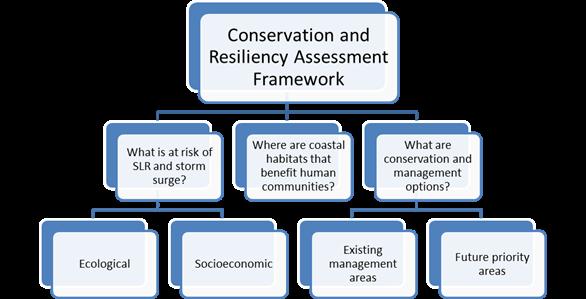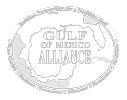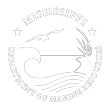Conservation and Resilience Analysis
Communities and Wetlands:
Coastal communities around the US are becoming increasingly aware of their vulnerability to coastal hazards including the effects of sea level rise and storm surge. Both the East Coast and Gulf of Mexico regions have large tracts of coastal wetlands which are susceptible to these hazards and contain habitats and human communities that are some of the most vulnerable in the continental United States. Local planners and property owners face great uncertainty about the potential impacts of SLR and storm surge on their communities. Having access to additional coastal resiliency tools can help improve their ability to assess the potential impacts of these hazards and lead to more informed decision making on how they can protect their communities from future threats while increasing the resiliency of their communities and wetlands, allowing them to better cope with these hazards if they do occur.
These increasing hazards threaten not only the human populations and built infrastructure, but also natural habitats and ecosystems in which their well-being depends on. Wetlands are among the Gulf of Mexico’s most economically and ecologically important habitats and comprise approximately 31% of land within the U.S. Gulf coastal watershed. These habitats provide many benefits for human and natural communities including storm surge protection, erosion prevention, nutrient cycling, pollutant removal, water supply and essential habitat for plant and animal communities, including key local and migratory species. An example of the economic importance of marsh ecosystems can be illustrated using the annual commercial shellfish harvest within the Gulf’s coastal wetlands, which was estimated at a value of $474 million in 2009. The Gulf of Mexico’s wetlands have experienced significant declines in recent decades and accelerated SLR projections are expected to further increase the rate and magnitude of wetland loss in the future.
Conservation and Coastal Resilience:
Nature holds some of the world’s best and most practical solutions to climate change, solutions that keep nature and people healthy, safe, and secure. Robust, resilient ecosystems can serve as protective buffers for human communities from sea level rise and storm events, while continuing to provide sources of food, fuel, fiber, and livelihoods – provided we manage them adequately to increase their resilience.
The Nature Conservancy (TNC) is working with partners at local and global scales to demonstrate how nature can provide cost-effective solutions to help sustain and protect human communities. Our coastal resilience strategy is about finding “win-win” approaches to adapting to the changing climate while meeting our conservation goals (http://coastalresilience.org). Coastal resilience is a spatial planning and conservation action approach that integrates appropriate coastal hazard, ecological, and socioeconomic information within geographies where planners and stakeholders are working together to design and implement ecosystem-based adaptation strategies. The Coastal resilience approach in this project consisted in identifying with local communities in our study areas to map sea level rise and other coastal hazards, natural resources, and human communities at risk that they thought threatened the capacity of marsh habitats to help them adapt to SLR. TNC in partnership with NOAA developed the publication Marshes on the Move, a marsh migration, change modeling and resilience framework that has motivated our work (http://www.csc.noaa.gov/digitalcoast/publications/marshesonthemove). This publication provides a basic understanding of the parameters and uncertainties involved in modeling the future impacts of sea level rise on coastal wetlands.
Ecosystem-based adaptation (EBA) includes a range of actions for the management, conservation, and restoration of ecosystems that will help reduce the vulnerability and increase the resilience of coastal communities. EBA is a cost-effective and accessible means of adaptation that can help address multiple threats and local priorities and is often more accessible to the rural poor than technology or infrastructure solutions. The essential points here are 1) EBA is about nature and people, not just one or the other; and 2) EBA is a part of a suite of other actions that together form a full adaptation strategy.
Framework for Assessment:
This project used the SLR and based storm surge model results to assess the ecological and socioeconomic components at risk of such climate hazards in each of the project sites, as well as what could be considered future conservation priorities to build a resilient coastal zone. Assessments of the impacts of SLR include the habitats (mostly coastal marshes) that are at risk of inundation and the social vulnerability of coastal communities to the different future scenarios used during these site specific analyses. Finally, the initiative identified wetland areas that need to be maintained to allow for flexibility and resilience to take effect.
Through a participatory stakeholder process regional stakeholders identified ongoing and future conservation planning efforts that were best suited to be informed by SLR and storm surge projections, socioeconomic indicators, and marsh migration scenarios. Through this effort the conservation analyses explore the following questions:
- What are the potential impacts of a 1 meter sea level rise to irregularly- and regularly-flooded marshes in the study area?
- Which communities are potentially most at risk to hurricane storm surge, and how might sea-level rise increase present-day risk to storm surge?
- Which communities might be most or least resilient to future changes based on socioeconomic indicators, inundation exposure, and marsh viability?
- How might SLR impacts and future marsh habitat distribution inform land acquisition and management planning?
Conservation and resiliency assessment framework used in site-specific analyses
Gilmer, B., J. Brenner, and J. Sheets. 2012. Informing Conservation Planning Using Sea-Level Rise and Storm Surge Impact Estimates in the Galveston Bay and southern Jefferson County area in Texas. The Nature Conservancy Report to the Gulf of Mexico Alliance. Seattle.
These analyses estimate the potential impacts of SLR and storm surge to human communities and natural habitats, with emphasis on coastal marsh land, in order to allow decision makers to more easily develop adaptation strategies that foster coastal resilience in the face of a changing climate. Our Conservation Analyses consist of one or more of the following outputs:
1. Marsh Change and Viability Analysis – identify the existing irregularly- and regularly-flooded marshes that are most likely to persist into the future, and those that are most threatened to be lost to SLR.
2. Community Risk Analysis: A conceptual risk framework was utilized to identify communities that face the highest risk to hurricane storm surge, and provide examples of how sea-level rise can increase present-day risk to storm surge.
3. Community Resilience Analysis: This analysis combines the Community Risk Analysis and Marsh Viability Analysis to identify communities that might be least (or most) resilient based on a community’s social vulnerability, exposure to storm surge, and the long-term viability of marsh systems within each block group.
4. Long-term Marsh Management Analysis: A high level gap analysis was performed to better inform existing and future land acquisition and management planning efforts which take into account the impacts of SLR.
The goal of the site-specific analyses performed in this initiative is to demonstrate examples of usage of the SLAMM and ADCIRC future scenarios to provide insight to future conservation planning efforts through SLR and storm surge projections, socioeconomic indicators, and marsh migration scenarios. Planning for and responding to a global threat such as SLR ultimately falls to regional and local decision makers. These decision makers need the critical information necessary to support choices for managing human and natural communities in the face of the coastal changes that are underway. Identifying and addressing the risks posed by SLR and other climate-related threats to ecosystems and infrastructure is of utmost importance to sustain a healthy flow of benefits to the coastal communities.






